Oak Ridge National Laboratory is managed by UT-Battelle LLC for the US Department of Energy
The Science
E = mc2. Einstein’s famous formula tells us that energy can be converted to mass. But there’s a catch – the mass must be equal amounts matter and anti-matter.
Immediately following the Big Bang the energy released was converted into mass, equally balanced between matter and anti-matter.
According to the laws of physics as they are currently known that balance would have been maintained. If that were true, shortly following the Big Bang every matter particle would have found a corresponding anti-matter particle, combined with it, and in a reverse of Einstein’s equation (mc2 = E) converted all the mass back into energy. The Universe would have been filled with light and nothing else.

Obviously – and fortunately for us – that didn’t happen!
But it almost did. Measurements of the abundance of light elements created during the Big Bang (isotopes of Hydrogen, Helium and Lithium) and measurements of the cosmic microwave background agree that the amount of matter remaining is a tiny fraction of what was initially created – less than one part per billion.

Something must have happened to shift the balance, ever so slightly, between matter and anti-matter; to create a slight excess of matter. As a result, even though most of the mass was converted back into energy a little bit of matter was left without any anti-matter partners to annihilate with. The stars, the earth, you and me… everything … is made of the matter that remained.

Oak Ridge National Laboratory is managed by UT-Battelle LLC for the US Department of Energy